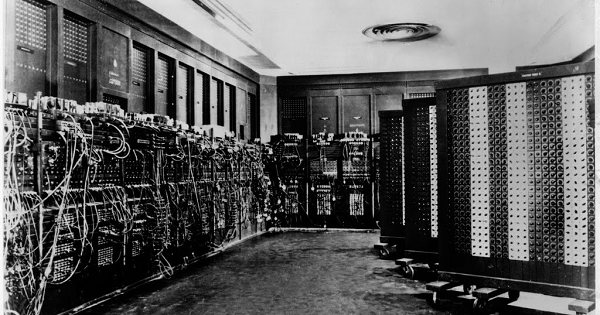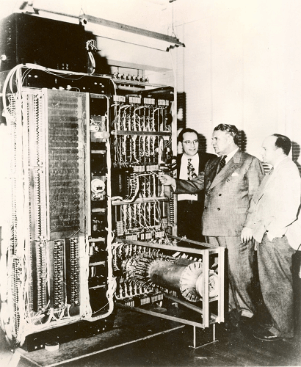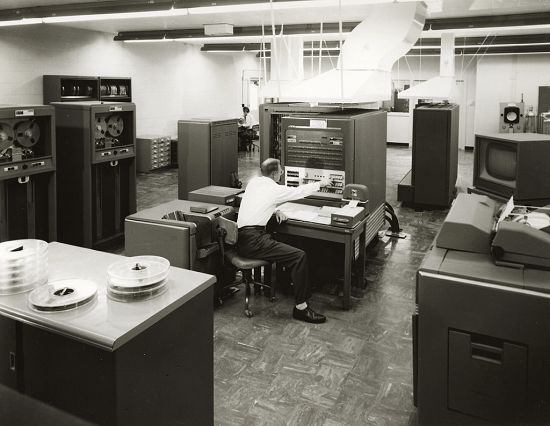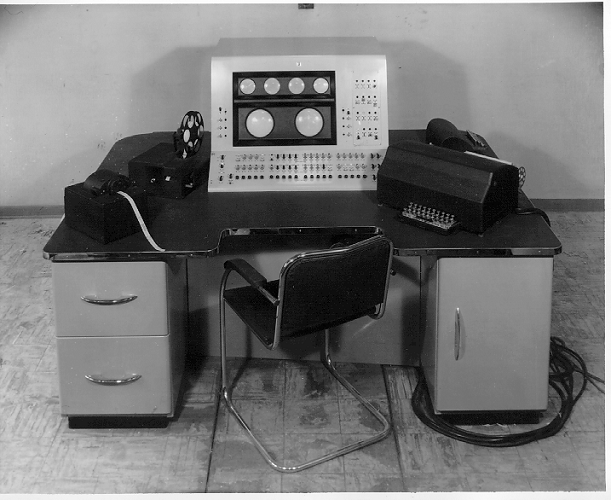First Generation of Computer
Computers in our world have become an integral part of our livelihood. Each task of our daily routine is related to the concept of a computer. From the Sector of Education to the Sector of healthcare, computers play a key role in each Sector's development. Most businesses in this new era rely on computers and the data stored in them. When we hear the word Computer, the first picture that comes to mind is of these small laptops and PCs or smartphones, which are different from how they were created.
History
The journey of the computer started so many years ago with the discovery of the Abacus. Modern-day computers are small, cheap, and portable. But the computers of the first age were way different as they were large enough to be set on a floor or more. They were very expensive to make and tough to transport once established.
Some of the First Computers were:
- Electronic Numerical Integrator And Computer (ENIAC) - 1945
- UNIVAC I (Universal Automatic Computer I) - 1950s
- IBM 701 - 1952
- IBM 650 - 1953
- Ferranti Mark 1 - 1951
The first generation of computers refer to the earliest computers developed in the late 1940s and 1950s. These computers were based on electronic vacuum tubes and used machine language, the lowest-level programming language, to perform their operations.
A Vacuum Tube is a device that uses a vacuum to amplify or switch electronic signals. It consists of a cathode, an anode, and a control grid, and it was widely used in the first generation of computers and various other electronic devices. Vacuum tubes were advantageous for their ability to amplify signals, but they were also large, prone to failure, and required a significant amount of power to operate. Despite these limitations, vacuum tubes played a significant role in modern electronics and computing. (Figure of Vaccum Tube Given Below)

First-generation computers marked a significant shift in how people thought about computation and information processing. They were the first machines to be able to execute a wide range of tasks, including calculations, data storage, and data retrieval. They were also the first computers to store and execute programs, making them much more versatile than their predecessors.
These computers were used for various purposes, including military, scientific, and commercial applications. Despite their limitations, they played a significant role in the development of modern computing and laid the foundation for future generations of computers.
ENIAC
The first electronic computer was the Electronic Numerical Integrator and Computer (ENIAC). John Mauchly and J. Presper Eckert invented it in 1945 at the University of Pennsylvania, United States of America.
The ENIAC was a large, bulky machine that took up an entire room. It was based on electronic vacuum tubes, which made it much faster than mechanical computers that relied on gears and levers. It was used primarily for military purposes, such as calculating ballistic trajectories, but it was also used for various scientific and commercial applications.
One of the main advantages of the ENIAC was its versatility. It was the first machine to be able to complete a wide range of tasks, including calculations, data storage, and data retrieval. It was also the first computer to store and execute programs, making it much more versatile than its predecessors.
Despite its many capabilities, the ENIAC had several limitations. It was very expensive to build and maintain, and it required specialized technicians to operate. It was also relatively slow by modern standards and required much maintenance to keep it running.
The ENIAC was a significant milestone in the history of computing and laid the foundation for the development of future generations of computers. Its development marked the beginning of the computer age, and it paved the way for developing more powerful and sophisticated computers that would come in the years and decades ahead.

UNIVAC
The first commercial computer is the UNIVAC I (Universal Automatic Computer I). It was developed in the 1950s by John Mauchly and J. Presper Eckert, the same team that developed the Electronic Numerical Integrator and Computer (ENIAC).
The UNIVAC I was based on the same technology as the ENIAC, but it was smaller and more practical for use in commercial settings. It was used for various business and scientific applications, such as payroll processing, inventory management, and weather forecasting.
UNIVAC I was known for its versatility. It performed a wide range of tasks, including calculations, data storage, and data retrieval. It was also able to store and execute programs, which made it much more versatile than its predecessors. It also had several limitations. It was still relatively expensive to build and maintain, and it required specialized technicians to operate. It was also relatively slow by modern standards and required much maintenance to keep it running.
Despite its limitations, the UNIVAC I played a significant role in the development of modern computing. It was the first computer to be used for commercial purposes, and it helped to demonstrate the practical applications of computing in business and other fields. It also paved the way for developing more powerful and sophisticated computers that would come in future generations.

IBM 701
The IBM 701 was a computer developed by IBM in 1952. It was based on electronic vacuum tube technology and used machine language, the lowest-level programming language, to perform its operations.
The IBM 701 was designed for scientific and commercial applications and used for data processing, payroll processing, and inventory. Like its predecessors, it was also used for scientific research, including weather forecasting and nuclear research.
Speed was the crucial feature that IBM 701 had. It was one of the fastest computers and could perform many tasks at high speeds. It was also relatively reliable and required relatively little maintenance compared to some of the alternatives that were available at the time.
Despite its many capabilities, the IBM 701 had several limitations. It was still relatively expensive to build and maintain, and it required specialized technicians to operate. It was also relatively slow by modern standards and had limited memory capacity as compared to modern computers.
IBM 701 played a significant role in the development of modern computing. It was an important milestone in the history of computing and helped demonstrate its practical applications in business and other fields. It helped pave the way for developing more powerful and sophisticated computers that would come in future generations.

IBM 601
The IBM 650 was a computer developed by IBM in 1953. It was based on electronic vacuum tube technology and used machine language, the lowest-level programming language, to perform its operations.
The IBM 650 was designed for scientific and commercial applications and used for data processing, payroll processing, and inventory management. It was also used for scientific research, including weather forecasting and nuclear research.
One of the main advantages of the IBM 650 was its versatility. It performed a wide range of tasks, including calculations, data storage, and data retrieval. It was also able to store and execute programs, which made it much more versatile than its predecessors.
Ferranti Mark 1
The Ferranti Mark 1 was a computer developed by Ferranti, a British electronics company, in 1951. It was based on electronic vacuum tube technology and used machine language, the lowest-level programming language, to perform its operations.
The Ferranti Mark 1 was designed for scientific and commercial applications and used for data processing, payroll processing, and inventory management. It was also used for scientific research, including weather forecasting and nuclear research.
Ferranti Mark 1 was also very reliable, like its predecessors. It was relatively reliable and required relatively little maintenance compared to some of the alternatives that were available at the time. It was also relatively fast and had a large memory capacity, making it well-suited for various applications.

Working of First Generation Computers
To understand how a first-generation computer works, it's helpful to understand the basic components of these machines. A first-generation computer typically consisted of the following components:
- Processing Central Unit (CPU): The CPU is the "brain" of the computer. It performs all the calculations and logic operations required to execute a program.
- Memory: The memory of a first-generation computer was typically made up of a series of magnetic drums or core memory units. It was used to store data and programs while the CPU was processing them.
- Input/Output Devices: First-generation computers use input/output devices, such as punched card readers, paper tape readers, and printers, to input and output data.
- Control Unit: The control unit was responsible for managing data flow and instructions between the CPU, memory, and input/output devices.
A first-generation computer would first read a program from its memory to perform a task. The program would be written in machine language, consisting of a binary code series that the computer could understand. The computer would execute the program by performing the calculations and logic operations required to complete the task.
First-generation computers were relatively slow and had limited processing and memory capabilities compared to modern computers. However, they were still able to perform a wide range of tasks and played a significant role in the development of modern computing.
Structure
First-generation computers were characterized by using vacuum tubes as the main electronic component. These computers were large, expensive, and required electricity to operate. They were also inclined to overheat and breakdowns.
The structure of a first-generation computer typically included the following components:
Input devices: First-generation computers used punch cards, paper tape, and other mechanical input devices to input data and instructions into the computer.
Central Processing Unit (CPU): The CPU is the "brain" of the computer and is responsible for executing instructions and performing calculations. In first-generation computers, the CPU consisted of vacuum tubes used to perform logical operations and temporarily store data.
Memory: First-generation computers had limited memory capacity, typically measured in kilobytes or less. They used magnetic drums, cores, or vacuum tube circuits to store data and instructions.
Output devices: First-generation computers used printers and punch card readers to produce output.
Power supply: First-generation computers require a large and powerful power supply to operate the vacuum tubes and other electronic components.
Cooling system: Due to the heat generated by the vacuum tubes, first-generation computers require a cooling system to prevent overheating. This typically consisted of fans or water cooling systems.
Advantages of First Generation Computer
First-generation computers, which were developed in the 1950s, marked a significant shift in the history of computing. Before this, computers were large, expensive, and not widely available. First-generation computers changed everything by using vacuum tubes to perform calculations and store data electronically.
One of the main advantages of first-generation computers was their speed. They could perform complex calculations much faster than any previous computing device, making them ideal for scientific calculations, data processing, and simulations.
Another advantage of first-generation computers was their accuracy. These computers were programmed to follow precise instructions, and their electronic components were highly precise, making them very reliable.
First-generation computers were also versatile, as they could perform various tasks. They were used in various industries, including government, military, science, and business, and helped automate many tasks and process large amounts of data.
Limitations of First-Generation Computers
First-generation computers, developed in the 1950s, significantly advanced in computing. However, they also had several limitations that were eventually addressed in the later generations of computers.
One of the main limitations of first-generation computers was their size. These computers were very large and required much space to operate. This made them difficult to use in small or portable settings, such as in homes or on the go.
Another limitation of first-generation computers was their cost. These computers were expensive to build and maintain, which made them not widely available to the general public. This limited their use to large organizations, such as government agencies and businesses, who could afford the high cost.
First-generation computers also had limited memory and storage capacity. They used magnetic drums, cores, or vacuum tube circuits to store data and instructions, which had a limited capacity compared to modern computer storage devices. This limited the amount of data that could be processed and stored.
In addition, first-generation computers require specialized knowledge and skills to operate and maintain. This made them difficult for the average person to use and required trained technicians to keep them running smoothly.
While first-generation computers were a significant technological advancement, they were limited by size, cost, and memory and storage capacity. They also required specialized knowledge and skills to operate and maintain, which made them not widely available to the general public.
First Step towards The Future
First-generation computers, developed in the 1950s, marked the beginning of the contemporary era of computing. These computers significantly improved over previous computing devices, as they used vacuum tubes to perform calculations and store data electronically.
First-generation computers paved the way for the development of later generations of computers by demonstrating the potential and capabilities of electronic computing. They were used in various industries, including government, military, science, and business, and helped automate many tasks and process large amounts of data.
The success of first-generation computers also led to the development of future technologies and innovations that improved their limitations. For example, the development of transistors in the late 1950s replaced vacuum tubes as the main electronic component in computers, leading to the development of second-generation computers.
The development of microprocessors in the 1970s, which are small, inexpensive, and low-power chips that contain all the components of a computer, further revolutionized the field of computing and led to the development of personal computers that were small, affordable, and widely available.
Overall, the development of first-generation computers laid the foundation for the modern era of computing and led to the development of many innovations and technologies that have shaped how we use computers today.